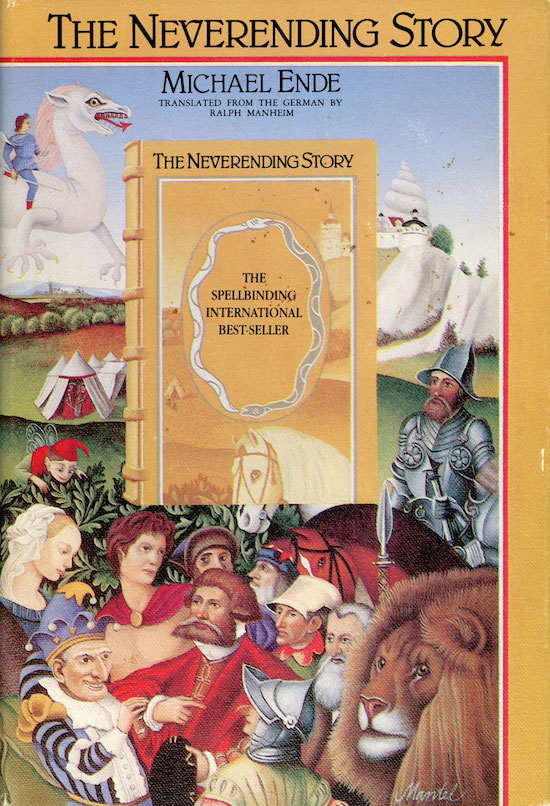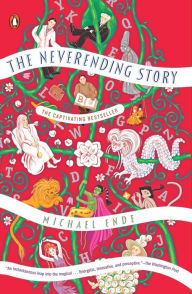The Neverending Story at 40: A Children’s Book Grappling with the Legacy of War
 Die unendliche Geschichte—better known in the U.S. under its translated title, The Neverending Story—celebrates its 40th anniversary this year. As the title suggests, there’s a lot there to unpack. The book is epic, meandering, sprawling; at times ponderous and at times immersive.
Die unendliche Geschichte—better known in the U.S. under its translated title, The Neverending Story—celebrates its 40th anniversary this year. As the title suggests, there’s a lot there to unpack. The book is epic, meandering, sprawling; at times ponderous and at times immersive.
It’s a story that is, in a word, Neverending.

Michael Andreas Helmuth Ende was born in 1929, a fraternal twin to the Great Depression. He spent his childhood in Bavaria, the son of a surrealist painter whose work would be declared “degenerate” by the Nazi regime. In 1935, a six-year-old Ende moved with his family to Munich, the Bavarian capital and the city that would, three years later, host the Munich Agreement, which ceded Sudetenland to Germany in an effort to prevent war. (That plan did not work out.)
Ende experienced his first air raid at the age of twelve, while in Munich. War was inescapable for him—he travelled to Hamburg to visit family just in time for “Operation Gommorah,” an Allied campaign of civilian and civic bombings that left around 35,000 civilians dead and an additional 125,000 injured. He saw the destruction of a once-great city; he saw a 460-meter-high tornado of fire; he saw the deaths of his friends and the imprisonment of his father.
He developed a love for poetry.
In the final year of World War II, at the age of fifteen, Ende received orders to join the Volkssturm and fight the Allies. Ende ignored his conscription orders and returned home to Munich, where the bodies of military deserters like himself had been strung up in the trees by the SS. He joined the Bavarian resistance and undermined the efforts of the SS until the war was over.
This was only the beginning of Ende’s life. He (perhaps unsurprisingly) grappled with depression and catastrophic thinking. He traveled far and wrote wide. He married twice and became a dedicated activist for human rights, peace, and disarmament. He was interested in cabaret, and Japanese ghost stories, and mysticism. He was deeply dedicated to the study of art.
All of Ende’s work is relevant to his literary legacy, and all of his influences are relevant to his writing, but Die unendliche Geschichte is his best-known work, and the influence of his childhood shines brightly in it. Here is an epic fantasy that is as leggy as a wild rose. Here is a book Ende wrote while wrapped in damp blankets during what was then the coldest Genzano winter in living memory. Here is the story of a boy who is trapped, first in his own life and then in a book that promises escape.
Here is the story of the Germany Michael Ende grew up in: Fantastica.

(Spoilers follow.)
The Neverending Story
The Neverending Story
By
Michael Ende
Translator
Ralph Manheim
In Stock Online
Paperback $18.00
The Neverending Story is about a boy named Bastian Balthazar Bux. Bastian is fat and clumsy and cowardly and not too terribly smart. He’s deeply lonely. He longs for a connection with his father, who is grieving the death of Bastian’s mother. When the reader meets Bastian, he’s sodden and dejected, seeking shelter inside an unwelcoming bookshop. Bastian winds up stealing a novel called The Neverending Story, and what follows is, at first anyway, a book-within-a-book.
The Neverending Story is about a boy named Bastian Balthazar Bux. Bastian is fat and clumsy and cowardly and not too terribly smart. He’s deeply lonely. He longs for a connection with his father, who is grieving the death of Bastian’s mother. When the reader meets Bastian, he’s sodden and dejected, seeking shelter inside an unwelcoming bookshop. Bastian winds up stealing a novel called The Neverending Story, and what follows is, at first anyway, a book-within-a-book.
The story Bastian reads is about the kingdom of Fantastica, which is being devoured by a terrifying force called “The Nothing.” A boy named Atreyu is tasked with finding the solution to this problem, and to the problem of the sickness that is killing the Childlike Empress—Fantastica’s benevolent, omnipotent, wholly objective ruler. Atreyu has a grand adventure in Fantastica, in the style of many epic fantasies; the story is, at least in part, an exercise in exploratory worldbuilding. (There are many people more qualified than I to examine Ende’s treatment of race, colonialism, and empire; I will simply say that there is plenty to discuss, especially with regards to Atreyu himself, and to Ende’s characters’ relationship to literary depictions of indigenous, First Nations, and Native American people and cultures).
Throughout Atreyu’s journey, which is classically adventurous and a richly entertaining story in its own right, one thing remains constant: the threat of the Nothing, which devours all and leaves only blankness behind. Taken on its own, this tale reads as a beautiful examination of grief and depression. Notably, it features perhaps the most infamous scene from the 1984 film adaptation, during which Atreyu’s companion and steed, Artax, succumbs to the pull of the Swamps of Sadness. In contrast to his already-heartbreaking depiction in the film as a standard-issue horse, the Artax of Die unendliche Geschichte is a talking horse; he voices every doubt and insecurity that Atreyu feels, but he does not have the protection of Atreyu’s magic gem to protect him from succumbing to those doubts. Artax questions whether the journey has a point at all, and encourages Atreyu to turn back and give up the quest to save Fantastica.
In the end, Artax explicitly tells Atreyu to abandon him, rather than watch him die.
The Neverending Story [Blu-ray]
The Neverending Story [Blu-ray]
Director
Wolfgang Petersen
Cast
Noah Hathaway
,
Barret Oliver
,
Tami Stronach
,
Gerald McRaney
,
Moses Gunn
In Stock Online
Blu-ray $16.99
This part of the narrative is striking for many reasons—and it will resonate on many levels, especially with readers who live with mental illness. The scene also works as a close-up rendering of the problems facing Fantastica; just as the Nothing is devouring the country, the relentless despair in the Swamps of Sadness devours Artax. Before this scene, the idea that the people and land of Fantastica are vanishing into the Nothing is relatively abstract. After Atreyu encounters personal loss, his quest to save Fantastica from destruction suddenly becomes personal and immediate. From this point forward, the stakes are significantly higher for him—ironically, the less he has to lose, the harder he fights.
This part of the narrative is striking for many reasons—and it will resonate on many levels, especially with readers who live with mental illness. The scene also works as a close-up rendering of the problems facing Fantastica; just as the Nothing is devouring the country, the relentless despair in the Swamps of Sadness devours Artax. Before this scene, the idea that the people and land of Fantastica are vanishing into the Nothing is relatively abstract. After Atreyu encounters personal loss, his quest to save Fantastica from destruction suddenly becomes personal and immediate. From this point forward, the stakes are significantly higher for him—ironically, the less he has to lose, the harder he fights.
It is impossible to read this scene without considering Ende’s childhood during the Great Depression and his adolescent experience of war. He watched his world change: watched it succumb first to financial calamity and then to fascism and then to fire. He watched the people around him change in the ways that many people change during times of great horror. He and his family moved to an artist’s quarter in Munich one year before the Nazis organized an exhibition of “degenerate art” designed to decry the very art styles Ende’s father and his community were most dedicated to creating; there can be no question that even within that one year, Ende will have witnessed the kind of despair he so sharply renders in Artax’s death.
The Nothing consumes Fantastica, just as the Great Depression and then the rise of violent fascist ideologies consumed Germany. By the time Atreyu becomes aware of the Nothing and the terrible vanishing of many parts of Fantastica, the problem is already spreading faster than anyone can escape it. This section of the novel is heavy with a feeling of helplessness and inevitability—feelings undoubtedly familiar to Ende, who was only four years old when Hitler was granted plenary powers by the Enabling Act. But Atreyu continues to fight, at times risking his life and often making great personal sacrifices in the name of saving Fantastica.
Atreyu’s quest makes up the first leg of The Neverending Story. The story pivots significantly after Atreyu discovers how to save Fantastica: an oracle informs him that Fantastica and its Childlike Empress can be saved by a human being, who must give the Childlike Empress a new name. This human being is, of course, Bastian, who (after a great deal of hesitation) enters the story and names the Empress “Moonchild.” The newly minted Moonchild presents Bastian with a single grain of sand—by now, all that is left of Fantastica—and a magical wish-granting gem that will obey and protect him at every turn, the same gem that protected Atreyu from despair in the Swamps of Sadness; it is hope, and will, and strength.
Bastian first exercises his control over the gem unconsciously, transforming himself into the thin, strong, handsome boy he’s always wished to be. He continues making wishes—to be strong and fast and brave, to have adventures and face monsters, to win the respect and admiration of the citizens of Fantastica. His wishes often serve to expand the restored world of Fantastica, creating creatures and people, lakes and forests, friends and foes for Bastian to face. He unites with Atreyu and together, they journey the land, ostensibly seeking a way for Bastian to get home.
But Bastian doesn’t actually want to get home, and so he delays their journey; while they take a meandering route to their destination, he becomes all-powerful and unconquerable.
This is a downside to his powers: every time Bastian makes a wish, he forgets something of what he once was. He doesn’t realize what he’s lost until it’s almost too late to find himself again. He becomes strong, and in so doing, he sacrifices the memory of ever having been weak; that sacrifice also causes him to strain to empathize with the weakness of others. He becomes brave, and forgets that he was ever a coward, and thus loses the ability to be gentle with those who are not as courageous as he is.
Eventually, Bastian wishes to be feared; his wish is granted, and he becomes consumed by the desire to hold power. Atreyu tries to intervene, but Bastian banishes him, surrounding himself only with those who tell him that he deserves the power for which he hungers. He makes his way to the seat of imperial power in Fantastica, the Ivory Tower, and claims it for himself. He installs himself as Emperor of Fantastica and demands fealty from all the people of the land—but Atreyu returns with a resistance force, and wages bloody battle to try to rescue his friend from the grip of his own hunger for power.
It’s simple enough to acknowledge that power and prosperity are appealing. Before Bastian is gifted the powerful gem that grants his every wish, he is deeply downtrodden, bullied and disdained by his peers and by the authority figures in his life. He rejoices at the promise of strength, courage, and respect. Who wouldn’t? In his character, Ende draws out a story of longing fulfilled by thorough and generous gratification—but by its very nature, that gratification leads to corruption. At the beginning of the book, Bastian is convinced that he should hate the person who he is; ultimately, his desire to be entirely different from the person he has always been results in him entirely losing the ability to love. He becomes cruel and confused, tired and angry. He alienates those who would have supported and loved the person he once was.
In fulfilling his every wish, Bastian causes horrific destruction. As effectively as the Nothing, he obliterates many of the most beautiful parts of Fantastica.

As a child, Ende watched Germany go through a rapid metamorphosis. He witnessed German rearmament, expansionism, and a flurry of propaganda that was aimed at reassuring Germans of a certain stripe that they were good. Not just good—great. Not just great—the ultimate ideal of humanity. Even if he didn’t understand what was happening on a political and global level, Ende would have witnessed the impact of this ideology on his friends and neighbors, his classmates and his country.
He lived inside of a country that felt bullied by the Treaty of Versailles; a country that felt powerless. He lived inside of a country that found a way to see itself differently—and he witnessed firsthand the resulting corruption, death, and destruction. The Germany Ende knew took Bastian’s journey, and many of the German people he knew and loved faced horrific consequences as a result of that journey.
Ende could not change the outcome of Germany’s descent into fascism—but he could write a different ending for Bastian.
Ultimately, the boy realizes the magnitude of what he has forgotten about himself. He realizes he must return to himself; he must remember how to love others, and he must learn to be loved for who he truly is. Through this, his final wish, Bastian returns home. He is himself again in form, but he is more self-assured, more honest and more kind. He reconciles with his father, who emerges from his deep depression to see the person his son has become.
It is a happy ending to a difficult book. One of the strengths of Die unendliche Geschichte is that it is a children’s book that doesn’t shy away from pain. Bastian is described as ten or twelve years old, and various sources place the book at a fifth- or sixth-grade reading level. This is a text aimed firmly at children, and it respects the complex experiences of those children. Fifth- and sixth-graders endure hardship and grieve; they live with mental illness, and they wrestle with questions of identity. They live through air raids and pogroms and the horrors of war.
Ende knew intimately that a child’s experience of the world encompasses more than just the simple joy we often ascribe to youth. He wrote a book that acknowledges that broad range of experiences—from the thrill of running faster than you knew you could, to the horror of realizing that you’re wholly alone in a world you’ve very nearly destroyed. He wrote a story of his own childhood in a country that, for a time, exchanged humanity for power. He wrote a story that he felt children needed to read; he wrote a story that respects what children can—but should never have to—endure.
He wrote Die unendliche Geschichte for all of us: for the people we have been, and the people we are now, and the people we might become, and the world we might wish into being together.
He wrote a story that will never end.

Author’s note: I didn’t read The Neverending Story in the original German, as it was written by Michael Ende. Consuming this book made me wish I knew the language, but I trust the translation work of Ralph Manheim, one of the most prominent and respected translators of the twentieth century. Manheim was responsible for the English translations of both Adolf Hitler’s Mein Kampf and the transcripts of Adolf Eichmann’s war-crimes trial in Jerusalem; he spent his college years in Munich and Vienna during the Great Depression, which struck Germany with unspeakable force.
I trust Manheim’s German. More importantly, I trust his commitment to accurate translation of authorial tone and intent: he is the one responsible for maintaining Hitler’s plentiful grammatical errors and baffling, meandering writing style. Perhaps most importantly of all, I trust his understanding of the world that shaped the man who wrote Die unendliche Geschichte. Because I read the English translation, it is impossible for me to discuss Ende’s work without also, simultaneously, discussing Manheim’s—but for the purposes of this essay, I assumed that the style and messages of book I read aligned with the one Ende wrote.
Not too much, Sarah Gailey. We still have a long way to go.

![The Neverending Story [Blu-ray]](https://prodimage.images-bn.com/pimages/0883929105878_p0_v4_s192x300.jpg)